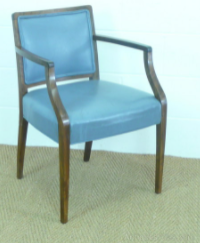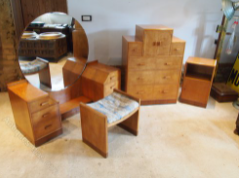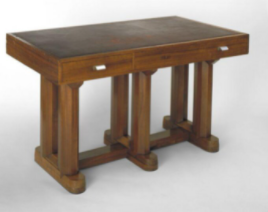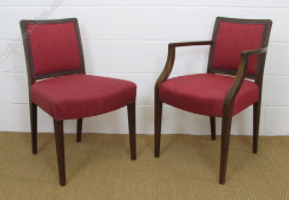The Cambridge Armchair was designed by Betty Joel, in 1935. With its curvilinear shapes and straightforward design, it’s the perfect example of the British modern aesthetics during the Art Decò Period.

Image source: https://www.antiques-atlas.com/antique/betty_joel_walnut_armchair__desk_chair/as157a430
Clean Lines for a Functional Chair
The Cambridge Armchair was part of a suite of furniture designed in 1935 for the consulting rooms of Harley Street eye surgeon F. A. Williamson-Noble. The set also included a desk, a wastepaper bin, and a letter tray, all made in the same Queensland silky oak. Influenced by the rich materials and clean lines of French Art Deco furniture, as well as the functionalism and craftsmanship of the Arts and Crafts movement, Joel sought to create a piece that was beautiful, practical and finely crafted.

Image source: https://www.nationalgalleries.org/art-and-artists/98618/mary-stewart-lockhart-mrs-betty-joel-le-touquet-france

Image source:https://www.antiques-atlas.com/antique/art_deco_betty_joel_bedroom_suite_fine_maple/as274a320
The Modern Aesthetic of Curvilinear Design
Beginning her design journey by producing pieces for her own house, Betty Joel soon realized that her furniture was highly demanded and resolved to set up a small factory at Hayling Island, London.

Image source: https://collections.vam.ac.uk/item/O370236/dressing-table/
Initially, much of the furniture was made in teak or oak. This was known as “Token” furniture, and the factory at Hayling Island was given the same name. The popularity of Joel’s design was such that by 1929 the factory moved to bigger premises at Portsmouth. During these times, Joel developed her own unique style: functionalism and the use of clean, curvilinear lines were the fundamentals of her designs and are clearly shown in pieces of furniture the like of the Cambridge Armchair and the Revolving Bed.

Image source: https://collections.vam.ac.uk/item/O144121/desk-joel-betty/

Image source:https://collections.vam.ac.uk/item/O129972/table-betty-joel-ltd/
Materials and Structure of the Cambridge Armchair
The Cambridge armchair is made of an Australian walnut frame, dowelled joints, and leather upholstery. The curvilinear shape and the use of exotic wood veneers, such as the Queensland silky oak, was typical of Joel’s style at the time.
The wooden armrests of the chair are an extension of the legs and compose the main structure of the piece. The backrest, a frame also in Australian wood, was originally designed without any cushion, but a new version was later produced which had it covered in leather. Finally, another version without armrests was designed and is currently available for purchase.

Image source: https://www.antiques-atlas.com/antique/set_of_6_betty_joel_walnut_dining_chairs/as157a452
Data Sheet
- Designer: Betty Joel;
- Year of design: 1935;
- Provenience: United Kingdom;
- Materials: leather, wood (Australian walnut and Queensland silky oak);
- Dimensions: 91.5 x 54,5 x 45 cm.
Info sources:
https://www.sellingantiques.co.uk/251648/set-of-6-betty-joel-walnut-dining-chairs/
